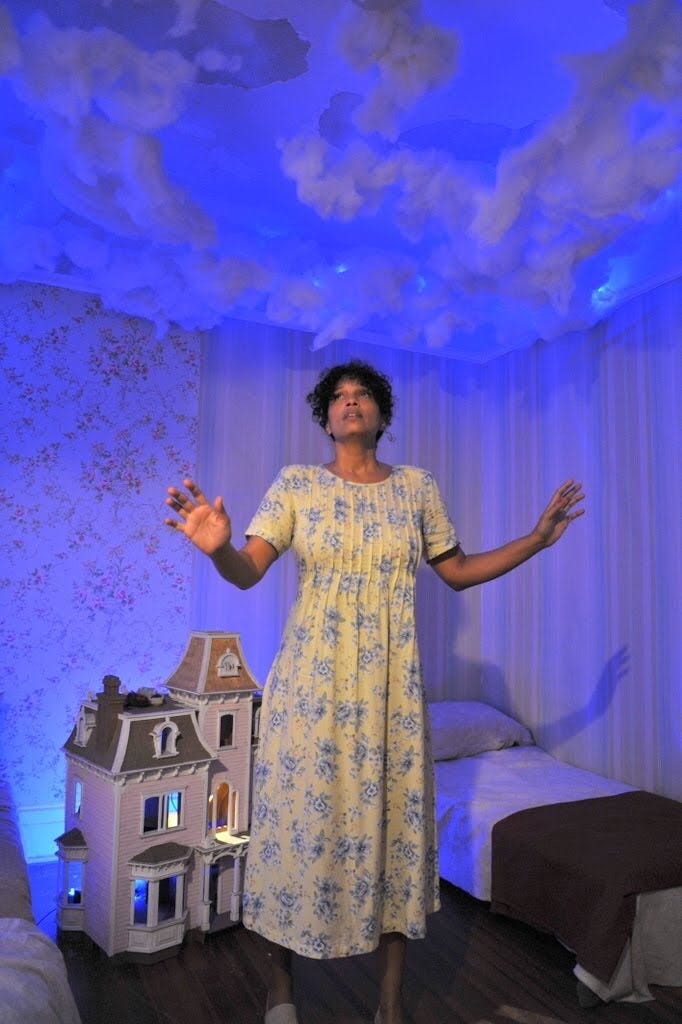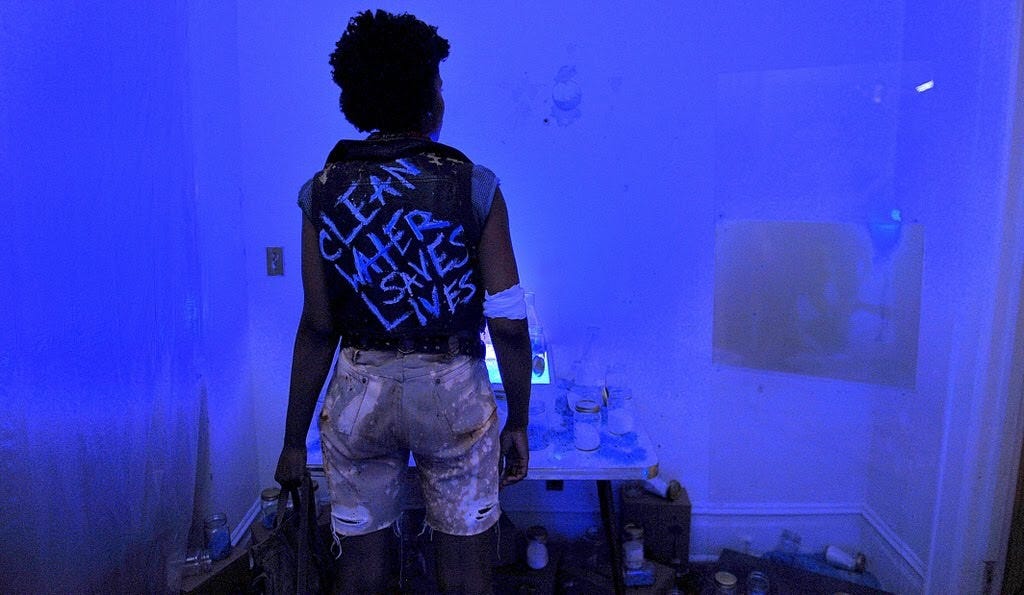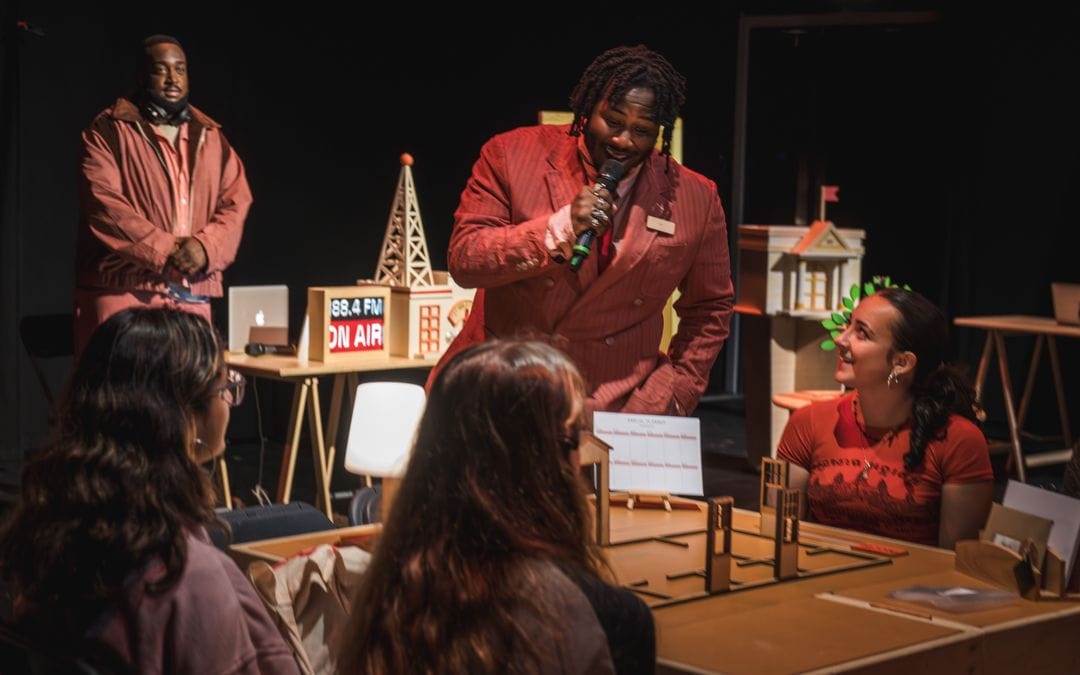
Taking long baths was a guilty pleasure of mine as a child. I know, as far as guilty pleasures go, there are far worse ones in the world. I was a weird child who relaxed like a cartoon of a 40-year-old woman, with my book and my drink and a snack in the tub. But also, I had a deep anxiety about the environment. I remember fantasizing about future Cub Scout campouts ruined by forests already shriveled and barren, sobbing my worries about overpopulation after being shown Soylent Green at way too young an age, and my frantic insistences to my parents that we start recycling or composting or whatever I had learned about in ecology class that week. So naturally, when I learned about our planet’s depleting water resources, my treasured bath time became tinged with fear.
With this baggage in tow, I have to say that the “bathtub” scene in the new immersive experience by Exquisite Corpse Company, Water, Water, Everywhere…, is my favorite one. The liveliest and most fleshed out character, the “spirit” of the old house on Governors Island, squeals with delight as she pulls an audience member into a fancifully decorated bathtub, rubber toys hanging above her from the ceiling like ripe fruit on a tree.
“It sounds wrong,” she giggles, “but I just love watching people in the bath! The little ones with their toys, the old ones with their books and wine and candles…all relaxing, all having fun!”
She offers the audience member their choice of bath toy, and asks him his favorite childhood bathtub memory. They then re-enact it in pantomime — making fluffy beards of soap bubbles. The scene is heartwarming and sweet, and perfectly characterizes the mischievous, always loving (and thus always hurting, losing) spirit of the house. I found myself transported back to my childhood bathtub, with a well-worn copy of The Hitchhiker’s Guide to the Galaxy, an orange, and a glass of ginger ale.
In retrospect, it’s funny that this scene stuck out to me: it really didn’t advance the message of the show at all. And that’s where the rub is. Water, Water, Everywhere… is a lot of fun, and is occasionally moving and affecting, but rarely achieves its goal of inciting action against climate change. A number of elements stand out, such as the elaborate sets and puzzle box of a plot that loops back on itself, constantly recontextualizing earlier moments. But the piece struggles to gel as a whole, and I find myself grasping for meaning as I look back at my experience.

Water, Water, Everywhere… is structured as a four-track promenade play, as groups follow one of four routes (chosen at random, but parties arriving together are deliberately separated), weaving between four different stories spanning the past, present, and future. One story, that of the spirit of the house itself, crosses through all others. Each room in the house on Governors Island that serves as the “set” is a treasure. Common household objects become surreal tableaus in the hands of the talented artists involved in creating the piece: cardboard boxes become a full living room, complete with a moose head on the wall; walls peel away to reveal hidden rooms; kitchens are full of earthy mounds of dirt overflowing with buried secrets. The show is driven by the device of a warped flow of time inside the house, forcing characters from multiple timelines into emotional, intense scenes, each one out of sync with its relative chronology. Take for example the spirit of the house: she is lamenting the tragedy she knows will befall the children in the past, despite the fact that the past and future have aligned, and are moving forward in perfect sync. Following the narrative in Water, Water, Everywhere… becomes a puzzle unto itself.
But the trouble I had with the show starts fairly early on. The audience doesn’t seem to be “cast” in the slightest; characters will acknowledge our presence occasionally, but most often talk as if we’re not in the room. While this could be excused by the temporally flexible setting, it made it hard to know how to react to scenes, and made any scenes with multiple actors awkward. Who were we to they? Were they concerned by the mass of people observing their intense conversations? Were the children of the present upset that I saw them cursing and sobbing when confronted with the phantoms of their family in the past? Could they even see us? These thoughts distracted from any sense of real immersion during Water, Water, Everywhere….

Some of the storylines seem better developed than others. It’s hard to tell whether the cast was hampered by the script or vice versa; either way, the “present” timeline comes off as stilted and irrelevant, and the “future” feels pedantic and shrill (yes, the future is a harsh wasteland, but does that have to be shouted at us in between lectures about the non-feasibility of large scale desalination?), while the “past” and timeless character of the house were thoughtful, exciting, and deeply emotional, especially once tragedy strikes during the performance. The storyline in the “present,” which follows two siblings reminiscing about their troubled time living in the house, lags in particular; I began to feel increasingly claustrophobic during one scene in a tiny room where the siblings reflected on a memory of their father for an overly long period of time. The sibling storyline also doesn’t seem to tie into the conservationist themes of the other three storylines. And to that point, even the conservationist themes didn’t seem to go anywhere during the experience.
Like most time travel stories, no matter how much the people from the past and the future communicate, the future stays the way it was. Fountain, our heroine from the future, seems to be doomed, trapped, and slowly dying of thirst, unable to escape to the more pleasant times (like the present and past) she could see, and even talk to. She was harsh and barked orders at us to raise a collection device for water, but I still felt terrible for her. But alas, the audience can’t cause a miracle. We’re not in Fountain’s time, and we can’t help her get a drink. Where does that leave us, though? An environmentalist story where the future feels immutable ends up bordering on nihilism. Instead of a call to action, the lush descriptions of the pleasures of drinking water and long soaks in the tub, all giddily delivered by the house spirit, had the opposite effect. I longed to enjoy the pleasures of water while it’s still plentiful, to go home and steep in my tub, with a full pitcher of iced tea by the side of the bath. If future generations are truly doomed, why shouldn’t the current generation enjoy what’s available right now?
To be fair, actually going through the Water, Water, Everywhere… experience is a treat. It’s exciting, fast-paced and packed with twists, the sets are gorgeous and a handful of scenes are deeply touching. However, it left me beyond bummed out afterwards. It raises interesting questions, sometimes in novel and beautiful ways, but also sometimes in harsh hysterics. And unfortunately the show doesn’t (at least on the track I was assigned to) answer them. Is it a good idea to love in a doomed world? Can we stop the environmental apocalypse? As the curtain falls, with Fountain screaming for someone to help her, I realize the show doesn’t offer any potential solutions. The message communicated in Water, Water, Everywhere… is that life is senseless and short, and every loving relationship eventually causes either pain or a disturbing detachment from reality. Of course, we can conserve now, do our part as individuals, but the main causes of environmental destruction are corporate and systemic — the average person can have very little impact. Water, Water, Everywhere… doesn’t even offer a great argument for individual efforts, and doesn’t acknowledge their meaning despite their seeming futility.
At the end of the day, after experiencing this piece, I unfortunately don’t feel moved, or compelled to action, just depressed. But let’s look at the bright side: it’s nothing a long bath and a cup of tea won’t solve — while they last.
Water, Water, Everywhere… continues on Governors Island through October 27. Tickets are $30–50.
NoPro is a labor of love made possible by our generous Patreon backers. Join them today!
In addition to the No Proscenium web site, our podcast, and our newsletters, you can find NoPro on Twitter, Facebook, YouTube, Instagram, in the Facebook community Everything Immersive, and on our Slack forum.
Office facilities provided by Thymele Arts, in Los Angeles, CA.





















Discussion